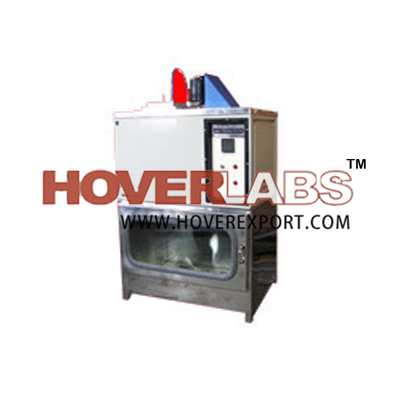Fogging Tester

Model ATM001
The Fogging Tester is specially designed equipment for
testing the fogging characteristics or VOCs of leather, plastics, vinyl and
textiles for automotive, aerospace and other transportation vehicles.
This fogging tester comprises of following equipment
- 1) Thermostatically Controlled Bath : Available with all
safety devices for over- heating, this is designed to operate at upto
130°C. All the parameters like bath capacity, circulation system and
heating system work in coordination as to control the temperature within ±
0.5°C throughout the bath. A slow and uniform speed is maintaining for the
agitation of bath.
- Note: There is a centrifugal pump at the bottom of some of the
heaters and circulators that enables the pumping of liquid at high speed
around the bath. Passing liquid in the beakers have different speeds and
this will cause differentiation in the temperatures of different beakers.
The distance between the bath fluid and lower surface of the glass plate should be 60 ± 2 mm. - 2) Cooling Plates : Hollow in structure, these cooling
plates are made from rust proof metals with aluminum on the side facing
the glass plate. These are specially designed for keeping the glass plates
cool. The cooling water flows through whole of the plate with two
connections. A minimum weight of 1kg should be maintained in the cooling
plate filled with to overcome the buoyancy of the beaker in the bath. For
each different beaker, a separate cooling plate is used. Designing of the
cooling plates and water thermostat is done in such a way that the mean
temperature of water remains at 21ºC and the temperature difference
between the inlet and outlet does not exceed 1ºC.
- 3) Flat bottomed beakers : These are made from heat-resistant
glass
- 4) Metal rings : Made from rust proof steel, these rings are
used to keep the test pieces flat.
- 5) Sealing rings : These rings are L- shapes or circular, made
from silicone or fluoro rubber.
- 6) Float-glass plates : These plates are available in
residential or windshield window quality for condensation of the fogging.
Available in tin and non- tin finish, these glass plates have reflecto
meter values within ± 2% units.
- Note: Identification of the tin and non-tin surfaces of the
glass plates can be done by viewing in a darkened room under a UV light at
254 nm wavelength. When exposed to UV light, the tin surface of the plate
will fluoresce.
- 7) Filter paper
- 8) Aluminum foil discs: These discs are stored in a
dedicator for avoiding condensation and contamination
- 9) Reflectometer: also known as gloss meter
- 10) Spacer: This type of spacer is specially installed
during relectometer measurements to prevent contact with the condensate on
the glass plate. These are made from high grade materials such as paper or
plastic with a circular hole for the measurements.
- 11) Dishwasher
- 12) Balance
- 13) Polyethylene gloves
- 14) Desiccators: These are available with suitable drying
material
TECHNICAL SPECIFICATIONS:
METAL RINGS:
- External diameter: 80mm
- Internal diameter: 74mm
- Height: 10mm
- Mass: 55±1g
SEALING RINGS:
- Inner diameter: 90mm to 95mm
- Thickness: 2mm to 4mm
- Hardness: 50 IRHD to 70 IRHD
FLOAT-GLASS PLATES:
- Thickness: (3 ± 0.2) mm
- Square with minimum dimensions: (110×100) mm
- Circular with diameter: 103mm
FILTER PAPER:
- Diameter: 110mm
- Mass per unit surface: 90 g/m2
ALUMINUM FOIL DISCS:
- Thickness: 0.03mm



